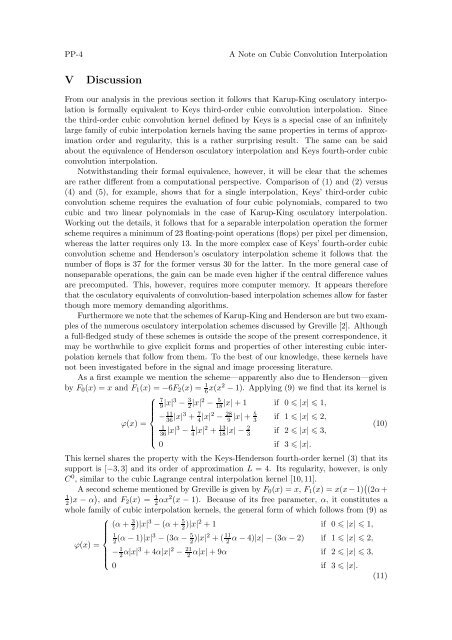A Note on Cubic Convolution Interpolation - Biomedical Imaging ...
A Note on Cubic Convolution Interpolation - Biomedical Imaging ...
A Note on Cubic Convolution Interpolation - Biomedical Imaging ...
Create successful ePaper yourself
Turn your PDF publications into a flip-book with our unique Google optimized e-Paper software.
PP-4A <str<strong>on</strong>g>Note</str<strong>on</strong>g> <strong>on</strong> <strong>Cubic</strong> C<strong>on</strong>voluti<strong>on</strong> Interpolati<strong>on</strong>VDiscussi<strong>on</strong>From our analysis in the previous secti<strong>on</strong> it follows that Karup-King osculatory interpolati<strong>on</strong>is formally equivalent to Keys third-order cubic c<strong>on</strong>voluti<strong>on</strong> interpolati<strong>on</strong>. Sincethe third-order cubic c<strong>on</strong>voluti<strong>on</strong> kernel defined by Keys is a special case of an infinitelylarge family of cubic interpolati<strong>on</strong> kernels having the same properties in terms of approximati<strong>on</strong>order and regularity, this is a rather surprising result. The same can be saidabout the equivalence of Henders<strong>on</strong> osculatory interpolati<strong>on</strong> and Keys fourth-order cubicc<strong>on</strong>voluti<strong>on</strong> interpolati<strong>on</strong>.Notwithstanding their formal equivalence, however, it will be clear that the schemesare rather different from a computati<strong>on</strong>al perspective. Comparis<strong>on</strong> of (1) and (2) versus(4) and (5), for example, shows that for a single interpolati<strong>on</strong>, Keys’ third-order cubicc<strong>on</strong>voluti<strong>on</strong> scheme requires the evaluati<strong>on</strong> of four cubic polynomials, compared to twocubic and two linear polynomials in the case of Karup-King osculatory interpolati<strong>on</strong>.Working out the details, it follows that for a separable interpolati<strong>on</strong> operati<strong>on</strong> the formerscheme requires a minimum of 23 floating-point operati<strong>on</strong>s (flops) per pixel per dimensi<strong>on</strong>,whereas the latter requires <strong>on</strong>ly 13. In the more complex case of Keys’ fourth-order cubicc<strong>on</strong>voluti<strong>on</strong> scheme and Henders<strong>on</strong>’s osculatory interpolati<strong>on</strong> scheme it follows that thenumber of flops is 37 for the former versus 30 for the latter. In the more general case ofn<strong>on</strong>separable operati<strong>on</strong>s, the gain can be made even higher if the central difference valuesare precomputed. This, however, requires more computer memory. It appears thereforethat the osculatory equivalents of c<strong>on</strong>voluti<strong>on</strong>-based interpolati<strong>on</strong> schemes allow for fasterthough more memory demanding algorithms.Furthermore we note that the schemes of Karup-King and Henders<strong>on</strong> are but two examplesof the numerous osculatory interpolati<strong>on</strong> schemes discussed by Greville [2]. Althougha full-fledged study of these schemes is outside the scope of the present corresp<strong>on</strong>dence, itmay be worthwhile to give explicit forms and properties of other interesting cubic interpolati<strong>on</strong>kernels that follow from them. To the best of our knowledge, these kernels havenot been investigated before in the signal and image processing literature.As a first example we menti<strong>on</strong> the scheme—apparently also due to Henders<strong>on</strong>—givenby F 0 (x) =x and F 1 (x) =−6F 2 (x) = 1 6 x(x2 − 1). Applying (9) we find that its kernel is⎧⎪⎨ϕ(x) =⎪⎩79 |x|3 − 3 2 |x|2 − 518|x| +1 if 0 |x| 1,− 1136 |x|3 + 7 4 |x|2 − 28 9 |x| + 5 3if 1 |x| 2,136 |x|3 − 1 4 |x|2 + 1318 |x|− 2 3if 2 |x| 3,0 if 3 |x|.This kernel shares the property with the Keys-Henders<strong>on</strong> fourth-order kernel (3) that itssupport is [−3, 3] and its order of approximati<strong>on</strong> L = 4. Its regularity, however, is <strong>on</strong>lyC 0 , similar to the cubic Lagrange central interpolati<strong>on</strong> kernel [10, 11].A sec<strong>on</strong>d scheme menti<strong>on</strong>ed by Greville is given by F 0 (x) =x, F 1 (x) =x(x − 1) ( (2α +12 )x − α) ,andF 2 (x) = 1 2 αx2 (x − 1). Because of its free parameter, α, it c<strong>on</strong>stitutes awhole family of cubic interpolati<strong>on</strong> kernels, the general form of which follows from (9) as⎧(α + 3 2 )|x|3 − (α + 5 2 )|x|2 +1 if 0 |x| 1,⎪⎨ 12ϕ(x) =(α − 1)|x|3 − (3α − 5 2 )|x|2 +( 11 2α − 4)|x|−(3α − 2) if 1 |x| 2,− 1 2⎪⎩α|x|3 +4α|x| 2 − 21 2α|x| +9α if 2 |x| 3,0 if 3 |x|.(11)(10)
















